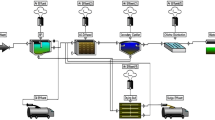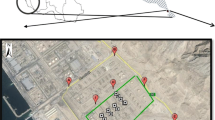Abstract
Air quality modeling plays an important role in prediction of air pollutants in urban areas. Moreover, it is also an essential component to make crucial decisions in environmental management. In this study, environmental protection agency (EPA) regulatory model (AERMOD) was implemented in order to assess the urban air quality in the city of Muscat, Sultanate of Oman. Dispersion modeling was employed for the prediction of hydrogen sulfide (H2S) emissions, a neighborhood claimed issue, from Al-Ansab sewage treatment plant (STP). Meteorological, elevation data, and H2S survey results were implemented into the model. From the site survey study, four different H2S emission sources were identified as sewage tanker connection points, biofilter, old odor control unit (OCU), and open channels of raw sewage. It was observed that based on maximum 24-h analysis, the ground level concentration outside the STP exceeded the concentration limit, 40 μg/m3, recommended by the local regulating agency in Oman. By applying a sensitivity analysis study, the locations with the highest predicted H2S levels were identified. The most affected area in the worst-case scenario was the nearby expressway with 450.9 μg/m3 of H2S. The highest ground level concentration of H2S was detected in March, while the lowest was measured in December. The model also predicted that the impact of odor nuisance is greater at the summer season than that of other seasons due to the elevated temperatures. The study revealed an adverse environmental impact from the STPs on urban air quality, which may pose a threat to the public health.






Similar content being viewed by others
References
Aatamila, M., Verkasalo, P.K., Korhonen, M.J., Suominen, A.L., Hirvonen, M.R., Viluksela, M.K. and Nevalainen, A. (2011). Odour annoyance and physical symptoms among residents living near waste treatment centres. Environmental Research, 111(1), 164–170.
Agus, E., Zhang, L., & Sedlak, D. L. (2012). A framework for identifying characteristic odor compounds in municipal wastewater effluent. Water Research, 46(18), 5970–5980.
Alison, J. V. (2001). Sources of odours in wastewater treatment, Odours in wastewater treatment: measurement, modelling and control. London, England: IWA.
Baawain, M. S., & Al-Serihi, A. S. (2014). Systematic approach for the prediction of ground-level air pollution (around an industrial port) using artificial neural network. Aerosol and Air Quality Research, 14(1), 124–134.
Baawain, M. S., Al-Omairi, A., & Choudri, B. S. (2014a). Characterization of domestic wastewater treatment in Oman from three different regions and current implications of treated effluents. Environmental Monitoring and Assessment, 186(5), 2701–2716.
Baawain, M. S., Al-Jabri, M., & Choudri, B. S. (2014b). Characterization of domestic wastewater sludge in Oman from three different regions and recommendations for alternative reuse applications. Iranian Journal of Public Health, 43(2), 168–177.
Baawain, M., Al-Mamun, A., Omidvarborna, H., & Al-Amri, W. (2017). Ultimate composition analysis of municipal solid waste in Muscat. Journal of Cleaner Production, 148, 355–362.
Cheng, Y., He, H. J., Yang, C. P., Zeng, G. M., Li, X., Chen, H., et al. (2016) Challenges and solutions for biofiltration of hydrophobic volatile organic compounds. Biotechnology Advances, 34(6), 1091–1102.
Chin, D. A., Mazumdar, A., & Roy, P. K. (2000). Water-resources engineering (Vol. 12). Englewood Cliffs: Prentice Hall.
Cimorelli, A. J., Perry, S. G., Venkatram, A., Weil, J. C., Paine, R. J., Wilson, R. B., Lee, R. F., Peters, W. D., Brode, R. W., & Paumier, J. O. (2004). AERMOD: description of model formulation. US Environmental Protection Agency, Office of Air Quality Planning and Standards, Emissions Monitoring and Analysis Division. EPA-454/R-03-004. Research Triangle Park, NC: US EPA.
Easter, C., Quigley, C., Burrowes, P., Witherspoon, J., & Apgar, D. (2005). Odor and air emissions control using biotechnology for both collection and wastewater treatment systems. Chemical Engineering Journal, 113(2), 93–104.
Estrada, J. M., Lebrero, R., Quijano, G., Kraakman, N. J. R., & Muñoz, R. (2013). Strategies for odour control. In Odour impact assessment handbook (pp. 85–124). New Jersey: John Wiley & Sons.
Fang, J. J., Yang, N., Cen, D. Y., Shao, L. M., & He, P. J. (2012). Odor compounds from different sources of landfill: characterization and source identification. Waste Management, 32(7), 1401–1410.
Gulia, S., Shrivastava, A., Nema, A. K., & Khare, M. (2015). Assessment of urban air quality around a heritage site using AERMOD: a case study of Amritsar City, India. Environmental Modeling & Assessment, 20(6), 599–608.
Halageri, N. (2012). Odor monitoring at wastewater treatment plants. University of New Orleans Theses and Dissertations, Paper 1580.
Hamoda, M. F. (2006). Air pollutants emissions from waste treatment and disposal facilities. Journal of Environmental Science and Health, Part A, 41(1), 77–85.
Heckel, P. F., & LeMasters, G. K. (2011). The use of AERMOD air pollution dispersion models to estimate residential ambient concentrations of elemental mercury. Water, Air, & Soil Pollution, 219(1–4), 377–388.
Iranpour, R., Cox, H. H., Deshusses, M. A., & Schroeder, E. D. (2005). Literature review of air pollution control biofilters and biotrickling filters for odor and volatile organic compound removal. Environmental Progress, 24(3), 254–267.
Jampana, S. S., Kumar, A., & Varadarajan, C. (2004). Application of the United States environmental protection agency’s AERMOD model to an industrial area. Environmental Progress, 23(1), 12–18.
Kaye, R., & Jiang, K. (2000). Development of odour impact criteria for sewage treatment plants using odour complaint history. Water Science and Technology, 41(6), 57–64.
Kumar, A., Dixit, S., Varadarajan, C., Vijayan, A., & Masuraha, A. (2006). Evaluation of the AERMOD dispersion model as a function of atmospheric stability for an urban area. Environmental Progress, 25(2), 141–151.
Latos, M., Karageorgos, P., Kalogerakis, N., & Lazaridis, M. (2011). Dispersion of odorous gaseous compounds emitted from wastewater treatment plants. Water, Air, & Soil Pollution, 215(1–4), 667–677.
Lebrero, R., Bouchy, L., Stuetz, R., & Munoz, R. (2011). Odor assessment and management in wastewater treatment plants: a review. Critical Reviews in Environmental Science and Technology, 41(10), 915–950.
McIntyre, A. (2000). Application of dispersion modelling to odour assessment: a practical tool or a complex trap? Water Science and Technology, 41(6), 81–88.
Nicell, J., & Henshaw, P. (2007). Odor impact assessments based on dose-response relationships and spatial analyses of population response. Water Practice, 1(2), 1–14.
Olesen, H. R., Løfstrøm, P., Berkowicz, R., & Ketzel, M. (2005). Ministry of the Environment. In Regulatory odour model development: survey of modelling tools and datasets with focus on building effects, Technical Report 541. Copenhagen: National Environmental Research Institute.
Parcsi, G., and Stuetz, R.M. (2007). Improving odour management and abatement performance using olfactory GC-MS. Proceedings of the II International Congress on Biotechniques for Air Pollution Control 15–28.
Poosarala, V. V., Kumar, A., & Kadiyala, A. (2009). Development of a spreadsheet for computing downwind concentrations based on the USEPA’s AERMOD model. Environmental Progress & Sustainable Energy, 28(2), 185–191.
Rosenfeld, P. E., & Suffet, I. H. (2004). Understanding odorants associated with compost, biomass facilities, and the land application of biosolids. Water Science and Technology, 49(9), 193–199.
Stuetz, R., & Frechen, F. B. (Eds.). (2001). Odours in wastewater treatment: measurement, modelling and control. London, England: IWA publishing. IWA.
US Environmental Protection Agency. (2004). AERMOD: description of the model formulation. In EPA-454/R-03-004. North Carolina: US Environmental Protection Agency, Research Triangle Park.
Van Broeck, G., Bogaert, S., & De Meyer, L. (2009). Monetary valuation of odour nuisance as a tool to evaluate cost effectiveness of possible odour reduction techniques. Odours and VOCs: Measurement, Regulation and Control Techniques, 31, 42.
Zarra, T., Naddeo, V., Belgiorno, V., Reiser, M., & Kranert, M. (2008). Odour monitoring of small wastewater treatment plant located in sensitive environment. Water Science and Technology, 58(1), 89–94.
Zhang, X. L., Yan, S., Tyagi, R. D., & Surampalli, R. Y. (2013). Odor control in lagoons. Journal of Environmental Management, 124, 62–71.
Acknowledgments
The authors would like to acknowledge the field and logistic support from Haya Water Company.
Author information
Authors and Affiliations
Corresponding author
Rights and permissions
About this article
Cite this article
Baawain, M., Al-Mamun, A., Omidvarborna, H. et al. Assessment of hydrogen sulfide emission from a sewage treatment plant using AERMOD. Environ Monit Assess 189, 263 (2017). https://doi.org/10.1007/s10661-017-5983-6
Received:
Accepted:
Published:
DOI: https://doi.org/10.1007/s10661-017-5983-6




